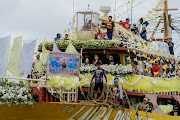His name says it all. “Maestro Nune”, or Teacher Nune, shows the people’s regard for visual artist Nunelucio Alvarado. Through his desire to bring art to his world, Maestro Nune has raised art awareness in Sagay City, Negros Occidental. He shares his talent and time with children who otherwise would not have access to art creation. More than that, he tells stories through his broad strokes and fine highlights. Maestro Nune’s body of work, appreciated here and abroad, speaks eloquently about the struggles of the common Negrense, proving once and for all that the task of teaching art is as critical to a people as teaching them their history.
The romance of life by the shore – the constant lapping of waves, the gentle breeze – brought Maestro Nune back to Margaha Beach where his forefathers once lived. Along the black sand beach stands Atalyer Avarado, residence and work studio to Maestro Nune. It is also home to his latest and grandest painting series, “Nawong Series” (Face Series). As of last count there are now over 4,000 different faces in the collection.
Margaha Bach has become synonymous with Maestro Nune. In 2013 its sandy shores became Instagrammable when the “Haligi sang Taliambong” (Pillars of Arts) was installed by Maestro Nune. The installation art consists of seven pillars depicting the seven disciplines of the arts, namely, visual arts, architecture, literature, cinema, music, dance, and theater. The pillars are actually trunks of felled trees from Typhoon Haiyan (locally named Super Typhoon Yolanda). In the worst of times, the pillars symbolize hope and resilience embodied in the arts, enthroned for the people.
When Nune met Sally, his artistry even flourished. Sally completely embraced Maestro Nune’s artistry and allowed him the space to do whatever he chose to do with his creative pursuits. She quickly learned that artists hate rules. That seems to be the essential ingredient to their marriage that has lasted 50 years.
Adjacent to Atalyer Alvarado is Kape Albarako, a coffee shop that Maestro Nune created for local artists to meet and exchange artistic insights. It also serves as art gallery. Here, workshops have been conducted and meetings held to plan annual events, like “Diin Tabo Man? Nature Encounter”, which takes place every February in celebration of National Arts Month.
Maestro Nune is a treasure to Sagay City, says Helen Cutillar, Information and Tourism Officer. Helen is one of Nune’s collaborators in pursuing art projects in Sagay. Aside from visual arts, Maestro Nune and the city have collaborated on an annual dance festival as well as a film festival that is quickly gaining traction. Together with local officials, Helen Cutillar helps in the campaign to make Maestro Nune a national artist.
Today, Maestro Nune’s art influence is ever more prominent, not just in annual undertakings but in day-to-day life. In his village called Purok Bouganvillea he has organized the “Pinta Balay” (Painted House) project where exterior walls and fences of homes have been painted bright tropical colors. Complementing this is another project, “Pinta Sikad” (Painted Trisikad). The trisikad is a for-hire bicycle with a sidecar that brings residents and visitors in and out of Margaha Beach. These trisikads have also been painted bright tropical colors. The effect is one of a cheerful, positive-vide neighborhood. This low-tech-high-thought branding effort has made the village and Margaha Beach all the more unique.
Text by: Alan S. Gensoli
Photos by: Bem Cortez
Video by: Grilled Cheese Studios
YouTube link : https://youtu.be/nFqIFDn5DMk
















